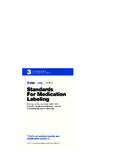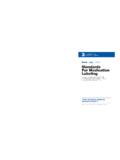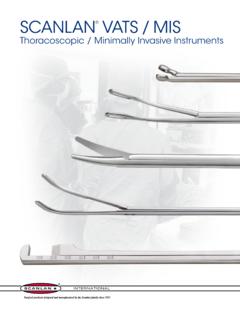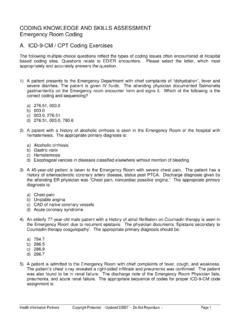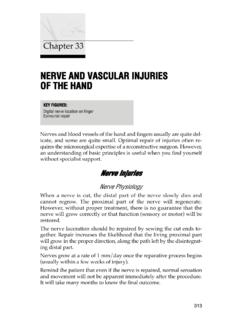Transcription of Scalpel Blades: Safety Center Reducing Injury
1 A Publication for the Prevention of Occupational Transmission of Bloodborne PathogensVOL. 6, NO. 4 2003 ADVANCES IN EXPOSURE PREVENTIONP ublished by theInternationalHealthcare WorkerSafety Centerat the University of VirginiaCenter Jane Perry, , Ginger Parker, , and Janine Jagger, , As a surgery attendant passed a scalpelto the surgeon, the surgeon simultaneouslyreached for it; they bumped hands and theattendant s left index finger was A physician and nurse completed ac-section and were cleaning the the nurse reached back for a towel,she was cut by a Scalpel held by the An attending surgeon was assisting theprimary thoracic surgeon with a lobec-tomy. As the attending withdrew his lefthand from the chest incision, he was cutby the Scalpel held by the primary Following an outpatient procedure anurse was cleaning up the equipment, andScalpel Blades: Reducing InjuryRiskused a hemostat to remove the blade from areusable Scalpel handle.
2 The blade slippedand the nurse cut her middle right A surgery attendant was reaching acrossa mayo stand to place a suture needle on aneedle board and was stuck by a scalpelblade lying on the DESCRIPTIONS OF Scalpel BLADE INJURIESto healthcare workers, from the EPIN etmultihospital sharps Injury database coor-dinated by the International HealthcareWorker Safety Center at the University ofVirginia, illustrate how Scalpel injuries canoccur in surgical settings. In EPINet datafrom 1993 to 2001, reusable and disposable Copyright Stockbyte; used with 2008, Interna-tional Healthcare WorkerSafety Center , University ofVirginia. May be down-loaded and reproduced onlimited basis for educationalpurposes only. No further re-production permitted withoutpermission of the Interna-tional Healthcare WorkerSafety IN EXPOSURE PREVENTION VOL. 6, NO.
3 4, 2003 Scalpel Blades: Reducing InjuryRiskscalpels together ranked third as acause of sharps injuries across allhealthcare settings, accounting for7% of injuries. In operating rooms(ORs) specifically, scalpels caused18% of injuries second only to su-ture needles, which caused 41% detailed analysis of scalpelblade injuries in surgical settings,based on the most recent two yearsfor which EPINet data is available(2000-2001; 133 Scalpel injuries, 35healthcare facilities contributingdata), reveals that Scalpel blades aremore likely than needles to causedeep or otherwise severe 39% of suture needle injurieswere classified as moderate (skincut, some bleeding) and 2% as se-vere (deep cut, profuse bleeding),these fractions were much higher forscalpels: 58% of injuries were clas-sified as moderate, and a full 11%as severe. This suggests a higherprobability of significant blood con-tact between patients and surgicalpersonnel from injuries involvingscalpel blades.
4 Cases of HIV trans-mission to healthcare workers fol-lowing Scalpel injuries have beendocumented in both the UnitedStates and Italy; they involved, re-spectively, a pathologist performingan autopsy and a When ascalpel Injury results in bleedingand the healthcare worker s handsare in or near the surgical site, thereis a further risk of healthcareworker-to-patient transmission ofbloodborne pathogens such as HIVor hepatitis vs. DisposableScalpelsReusable scalpels , which re-quire removal of the blade in or-der to reuse the handle, causedmore than twice as many injuriesin this analysis as disposable scal-pels, which eliminate this step(68% of Scalpel injuries werecaused by reusables, 32% bydisposables). It appears, however,that use of reusable scalpels maybe declining: in EPINet data from1993-94 for percutaneous injuriesin ORs, 21% of OR injuries werecaused by reusable scalpels , whileonly were caused bydisposables; in 2000-2001 data,the fraction of injuries caused byreusables was muchlower, while the proportion of in-juries from disposables, ,had increased significantly (seefigure 1).
5 Figure 1. Injuries in Surgical Settings from Scalpel Blades: Reusable vs. Disposable Scalpels05101520251993-19942000-2001% of OR injuriesReusable scalpelsDisposable scalpelsEPINet 1993-94: 55 healthcare facilities; 1,703 total injuries in ORsEPINet 2000-2001: 52 healthcare facilities; 961 total injuries in ORsInternational Healthcare Worker Safety Center , Univ. of VirginiaWho is Injured, and WhenIn EPINet data for 2000-2001,surgery attendants sustained thelargest proportion of Scalpel injuries(36%), followed by nurses (27%),physicians (18%), and surgery tech-nicians (9%) (see figure 2, page 39).In 76% of cases, the injured workerwas not the original user of the scal-pel. This is particularly significantbecause many injuries from scalpelsoccur when surgeons are passingthem to nurses or other OR person-nel. The largest proportion of scal-pel injuries occurred between stepsof a multi-step procedure (41% or54/133) (see figure 3, page 39).
6 Ofthese 54 cases, 12 workers specifi-cally noted in the description areaof the EPINet form that the injuryoccurred during passing (other be-tween steps injuries may have in-volved passing as well, but were notnoted as such by the injuredworker). An additional 31% of scal-pel injuries occurred during use, and10% during disassembly. When weseparated Injury data in the disas-sembly category for reusable anddisposable scalpels , we found twiceas many injuries during disassem-bly for reusables compared todisposables. (When workers indi-cate during disassembly for dis-posable scalpels , they may possi-bly mean the Injury occurred dur-ing activation of the Safety can occur during this stepif two hands are used to activatethe shield instead of one. Activat-ing the shield should be a one-handed operation, using thethumb to slide the shield over theblade or the blade into the parts of the hand thus remainbehind the blade.)
7 An additional 14% of scalpelinjuries occurred after use but be-fore disposal (this category excludesdisassembly injuries) or during orafter disposal; these injuries couldpotentially be eliminated by usingsafety-designed scalpels where theblade can be covered between uses3939393939 ADVANCES IN EXPOSURE PREVENTION Vol. 6, No. 4, 2003 Scalpel Blades: Reducing InjuryRiskand after use. But, in 90% of casesworkers reported that the scalpelthat injured them was not a largest proportion ofscalpel injuries, 94%, were to thehands; 3% were to the arms, and2% to the feet. The right hand sus-tained 56% of injuries, and the lefthand, 38%; this Injury pattern maybe related to hand-to-hand pass-ing, in which the dominant hand(usually the right one) is used toreceive Scalpel injuriesTo reduce injuries from scal-pel blades, a variety of preventionstrategies are needed that targetthe different mechanisms of scal-pel with shielded or re-tractable blades that can be placedin a protected position during pass-ing and after use have the potentialto prevent a large proportion of scal-pel injuries as many as 65% ifused consistently and , it is important to docu-ment actual compliance in activat-ing the Safety feature, as well as pre-vention Safety scalpelsshould be used preferentially to re-usable ones, to reduce injuries as-sociated with disassembly.
8 How-ever, there may be some proceduresfor which reusable scalpels are stillthe only option. For example, somesurgical procedures (such as thosein deep cavities like the chest) re-quire an extended length scal-pel to reach the tissue being Safety scalpels are notyet available in these extendedlength that occur during cut-ting may be prevented by using al-ternative cutting methods when ap-propriate, such as blunt-tip scissors,blunt electrocautery devices, andlaser devices. Other strategies in-clude substituting round-tip forsharp-tip Scalpel blades (blades withpointed tips cause more severe in-juries than ones with round tips),and choosing endoscopic surgeryinstead of open surgery when pos-sible. Manual tissue retraction(which puts fingers in closer prox-imity to the Scalpel blade) should beavoided by using mechanical retrac-tion hands are the body areamost frequently injured by scal-pel blades, their protection re-quires special attention.
9 Nogloves provide total protectionfrom cuts, but ones made of steelmesh, Kevlar, leather, or knittedcut-resistant yarn are resistant tolacerations and can be worn un-der latex or vinyl gloves2; theseare particularly relevant for thenon-dominant hand, where theadded bulk interferes less of sharp de-vices during surgery can help reducepassing-related injuries that resultfrom collisions between hands andsharp instruments; it involves des-ignating a neutral or safe zone,such as a mat, tray, or specially de-signed surgical drape, where instru-ments can be placed and picked 2. Job Category of Workers Sustaining Injuries from Scalpel Blades in Surgical SettingsEPINet, 35 healthcare facilities, 2000-2001, 133 casesPhysician- attending ( )Other ( )Technologist/non-lab ( ) Nurse( )Surgery attendant( )Physician-intern/resident( )International Healthcare Worker Safety Center ,University of VirginiaFigure 3.
10 Mechanism of Scalpel Blade Injuriesin Surgical Settings051015202530354045during usebetween steps of a multi-step proceduredisassemblingpreparing for reuseother after use, before disposaldisposal-relatedother% of cases International Healthcare Worker Safety Center , University of VirginiaEPINet, 35 healthcare facilities, 2000-2001, 133 cases4040404040 ADVANCES IN EXPOSURE PREVENTION VOL. 6, NO. 4, 2003 Another important Safety strat-egy is avoiding unnecessary speedand motion. Surgeon Mark Davis,in his book Advanced Precautionsfor Today s OR, notes: Whensharps are in use on the [surgical]field, there is rarely a need for ex-cessive speed. The most technicallyproficient surgeons finish proce-dures faster than less experiencedsurgeons not by the use of rapidhand motion but by avoiding unnec-essary and repetitive movements. Good verbal communication isalso important for Injury preven-tion: When a sharp is in use,avoid anticipating motion ofanyone s hands; wait for the sur-geon to request sponging.
